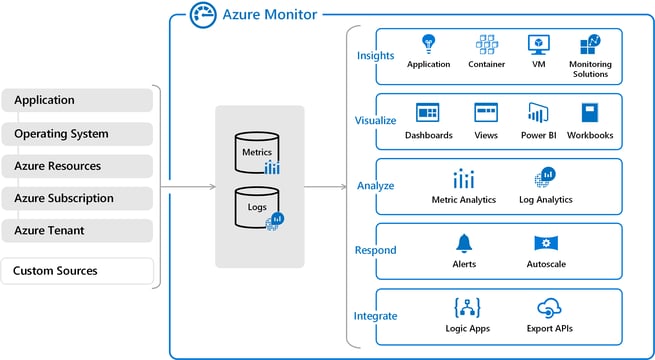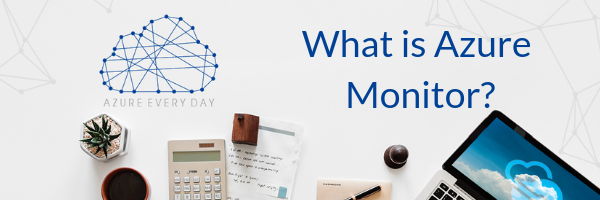

Want to have increased confidence in your Azure environment? Today, I’ll tell you about Azure Monitor which gives you that increased confidence with real time monitoring and alerting.
Azure Monitor maximizes the availability and performance of your applications by delivering a comprehensive solution for collecting, analyzing and acting on telemetry from the cloud and on-premise environments. Thus, allowing you to have confidence in your Azure resources without the need to constantly live in the portal to see if there’s some degradation.
Azure Monitor uses two sources of data to identify an action:
.png?width=3162&name=Monitor%200.17-0.27%20(1).png)
- Metrics are numerical values that describe an Azure system at a point in time. These are known for being lightweight and capable of near real time reporting. Using the Metrics Explorer, you can easily graph these metrics over time to see trends and outliers in a more visual manner.
.png?width=673&name=Monitor%200.43-0.53%20(1).png)
- Logs are different types of data, organized into records of varying properties (not necessarily numeric). This data is usually telemetry data like events or traces. You can query this data to uncover patterns using log analytics. And, like the Metrics Explorer, this data can be turned in a graphical format for reporting.
-1.png?width=671&name=Monitor%201.00-1.150%20(1)-1.png)
The Monitor collects different types of data across the environment:
- Platform independent application data - collected to describe the performance of the code running in Azure.
- Guest OS data - collected to give specifics around types of VM operating systems you have hosted in Azure.
- Resource, subscription and tenant monitoring – tracks data about the Azure framework itself, each covering the level as described in the name such as date, date modified, last modifier, etc.
If you have a tenant with at least one subscription or resource, data is already being collected in your Azure environment. Data search will be collected on creation for subscriptions and resources of various types. This data, mostly falling into the activity log or metrics categories, starts recording basic events such as creation time and user baseline performance metrics.
You can also utilize agents, compute resources or any REST API client in the Azure data collector API to obtain more advanced metrics and log data.
When it comes to using this data, first and foremost, this data can be easily graphed for custom visuals and dashboards built into the Azure Monitor or by exporting Power BI for unlimited possibilities and flexibility. However, this requires you to go somewhere and look to ensure the stability of your environment.
.png?width=1263&name=Monitor%202.28-2.38%20(1).png)
Alternatively, you can set up alerts in Azure Monitor, allowing you to send an email, SMS push notification or a webhook to another service based on a metric or log exceeding a threshold over a given time period. You can used this in conjunction with the visuals, so you will be notified when you should go look at your dashboard to see something going on with the system.
If you find yourself constantly performing the same set of steps as a result of the alert, why not automate? You can integrate automation in Azure Monitor through Runbooks or Logic Apps to run a sequence of steps such as scaling/out, granting or removing access or even activating an entire VR strategy – all without human interaction.
Finally, you can export this data to the any security or monitoring tool you choose. Something to keep in mind is that retention is a key factor when working with Azure Monitor. You must find that sweet spot between retention and purging. If your attention period is too short, you may miss out on vital information that may have given you greater insight in an emergency.
On the contrary, having unnecessarily long retention could mean paying for data you never intend to use. Best practice is to ensure your retention matches your retention policy of your security and IT staff.
Increased confidence in your Azure environment—who wouldn’t want that? If you have questions about Azure Monitor or any other Azure product or service, we’re here to help. Click the link below or contact us to start a conversation about how we can help you use Azure to take your business from good to great.
Sign-up now and get instant access

ABOUT THE AUTHOR
Free Trial
On-demand learning
Most Recent
private training







-1.png)
Leave a comment